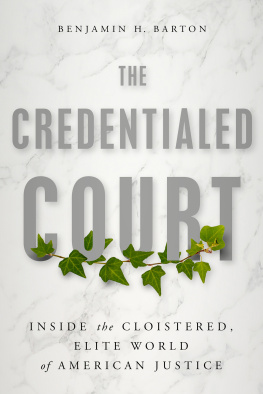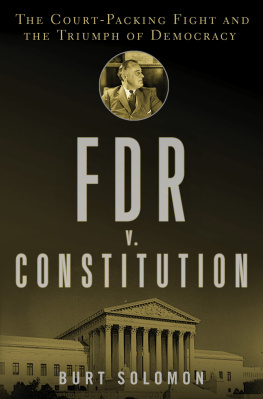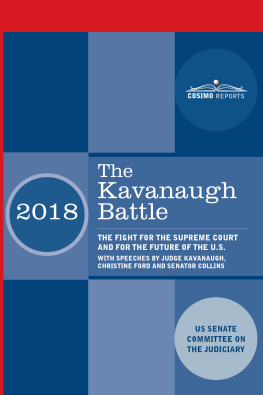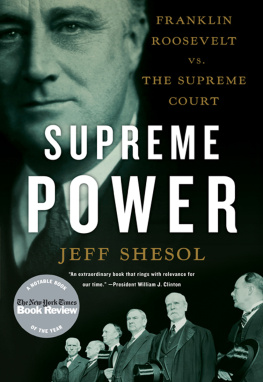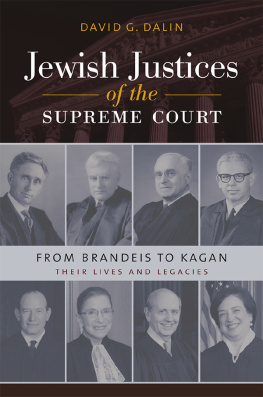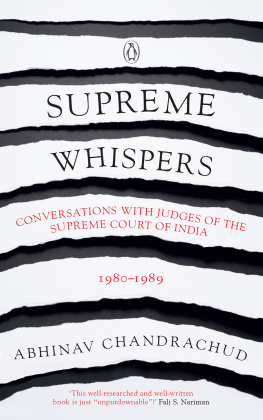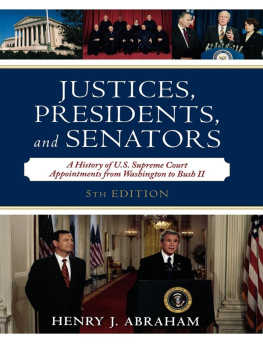Norman Vieira - Supreme Court Appointments: Judge Bork and the Politicization of Senate Confirmations
Here you can read online Norman Vieira - Supreme Court Appointments: Judge Bork and the Politicization of Senate Confirmations full text of the book (entire story) in english for free. Download pdf and epub, get meaning, cover and reviews about this ebook. year: 1998, publisher: SIU Press, genre: Science / Business. Description of the work, (preface) as well as reviews are available. Best literature library LitArk.com created for fans of good reading and offers a wide selection of genres:
Romance novel
Science fiction
Adventure
Detective
Science
History
Home and family
Prose
Art
Politics
Computer
Non-fiction
Religion
Business
Children
Humor
Choose a favorite category and find really read worthwhile books. Enjoy immersion in the world of imagination, feel the emotions of the characters or learn something new for yourself, make an fascinating discovery.
- Book:Supreme Court Appointments: Judge Bork and the Politicization of Senate Confirmations
- Author:
- Publisher:SIU Press
- Genre:
- Year:1998
- Rating:4 / 5
- Favourites:Add to favourites
- Your mark:
- 80
- 1
- 2
- 3
- 4
- 5
Supreme Court Appointments: Judge Bork and the Politicization of Senate Confirmations: summary, description and annotation
We offer to read an annotation, description, summary or preface (depends on what the author of the book "Supreme Court Appointments: Judge Bork and the Politicization of Senate Confirmations" wrote himself). If you haven't found the necessary information about the book — write in the comments, we will try to find it.
Norman Vieira: author's other books
Who wrote Supreme Court Appointments: Judge Bork and the Politicization of Senate Confirmations? Find out the surname, the name of the author of the book and a list of all author's works by series.
Supreme Court Appointments: Judge Bork and the Politicization of Senate Confirmations — read online for free the complete book (whole text) full work
Below is the text of the book, divided by pages. System saving the place of the last page read, allows you to conveniently read the book "Supreme Court Appointments: Judge Bork and the Politicization of Senate Confirmations" online for free, without having to search again every time where you left off. Put a bookmark, and you can go to the page where you finished reading at any time.
Font size:
Interval:
Bookmark:
title | : | Supreme Court Appointments : Judge Bork and the Politicization of Senate Confirmations |
author | : | Vieira, Norman.; Gross, Leonard |
publisher | : | Southern Illinois University Press |
isbn10 | asin | : | 0809322048 |
print isbn13 | : | 9780809322046 |
ebook isbn13 | : | 9780585030166 |
language | : | English |
subject | United States.--Supreme Court--Officials and employees--Selection and appointment--History, Judges--Selection and appointment--United States--History, Bork, Robert H, Political questions and judicial power--United States. | |
publication date | : | 1998 |
lcc | : | KF8742.V54 1998eb |
ddc | : | 347.73/2634 |
subject | : | United States.--Supreme Court--Officials and employees--Selection and appointment--History, Judges--Selection and appointment--United States--History, Bork, Robert H, Political questions and judicial power--United States. |
Supreme Court Appointments:
Judge Bork and the Politicization of Senate Confirmations
Southern Illinois University Press
Carbondale and Edwardsville
Copyright 1998 by the Board of Trustees,
Southern Illinois University
All rights reserved
Printed in the United States of America
01 00 99 98 4 3 2 1 Library of Congress Cataloging-in-Publication Data Vieira, Norman.
Supreme court appointments: Judge Bork and the politicization of Senate confirmations / Norman Vieira and Leonard Gross.
p. cm.
Includes bibliographical references and index.
1. United States. Supreme Court Officials and employees Selection and appointment History.
2. Judges Selection and appointment United States History.
3. Bork, Robert H.
4. Political questions and judicial power
United States. I. Gross, Leonard, 1951- . II. Title.
KF8742.V54 1998
347.73'2634-dc21
ISBN 0-8093-2204-8 (cloth: alk. paper)
98-15735
CIP The paper used in this publication meets the minimum requirements of American National Standard for Information Sciences Permanence of Paper for Printed Library Materials, ANSI Z39.48-1984.
This volume on Supreme Court appointments grew out of the controversy surrounding President Reagan's nomination of Judge Robert Bork to succeed Justice Powell on the Supreme Court. Because few knowledgeable observers questioned Judge Bork's professional qualifications, opposition to Bork quickly focused on his judicial philosophy. The focus on ideology raised a crucial issue as to whether it was proper for the Senate to reject for ideological reasons an otherwise qualified nominee. This book analyzes the Bork proceedings and the role of judicial ideology in the confirmation process. It also examines all of the post-Bork appointments to the Supreme Court. In these endeavors, we have relied on interviews with major participants in the confirmation process, as well as on traditional primary materials like committee hearings and Senate debates. We are grateful for the help of Gregg Walters, Nancy Stanley, and other research assistants. It is significant that the fallout from the Bork confirmation battle has not abated in more than ten years following the event. Indeed, the impact of the Bork precendent has now reached beyond Supreme Court appointments to affect the nomination of judges for all federal courts and even the selection of candidates for cabinet and subcabinet positions. Just this year, the Washington Post reported that "[n]early 10 percent of the 846 seats on the federal bench are now empty, and the Senate has confirmed only 53 judicial nominees over the past two years," compared with 101 confirmations in 1994 alone. Chief Justice Rehnquist has warned that "vacancies cannot remain at such high levels indefinitely without eroding the quality of justice" (Washington Post, Jan. 3, 1998, A20). But Senator Orrin Hatch, who chairs the Senate Judiciary Committee, responded that the problem stems from President Clinton's nomination of "activist judges," and other Republican senators have said that they would strongly oppose the confirmation of judicial nominees who hold "activist views." It is apparent, therefore, that the issue of ideological qualification for service on federal courts has lost none of its vitality in the years following the Bork proceedings.
Powell's clerks were surprised, but not shocked. 1 For several years, Justice Powell had been rumored to be in ill health. He had undergone major surgery three times since coming to the Court, including most significantly, surgery for prostate cancer in 1985. Moreover, he had told President Nixon at the time of his appointment that he did not expect to stay on the Court for more than ten years. In fact, Powell had thought seriously about leaving the Court in 1982, but his children persuaded him to stay.2 Now, as he approached his eightieth birthday, it was time to reconsider. Powell called his clerks into his office as the Court was about to end its 1986 Term and, without fanfare, quietly announced that he had decided to retire and assume senior status. None of his clerks believed that Powell was under any outside pressure to leave or that, if there had been any pressure, it would have made any difference to him. His clerks thought Powell "left with a great deal of regret. He was still mentally and intellectually capable. He loved his job so much, and he wanted to go out while he was on top. Yet, he thought it was in the best interest of the Court for him to retire."3 In his farewell press conference, Powell expressed concern that he might handicap the Court if he experienced a recurrence of serious health problems.4 In the past, some justices had tried to time their resignations so as to maximize the chance that a successor would be appointed who would carry forward their views. Chief Justice Earl Warren tendered his resignation to President Johnson in June 1968 "effective at your [Johnson's] pleasure"5 in an apparent attempt to give Johnson, a fellow liberal, the opportunity of appointing his successor.6 Warren was unsuccessful because conservative senators blocked Johnson's appointment of Abe Fortas to be chief justice. Similarly, Justice William O. Douglas tried to postpone his retirement in order to deny President Ford the opportunity to name his successor.7 However, Douglas's ill health prompted the Court to order reargument in any case in which his vote was decisive, an order tantamount to refusing to count his vote when it mattered most. That action eventually induced Douglas to retire.8 A few years later, Justice Stewart, then about to leave the Supreme Court, told Vice President Bush that other justices contemplating retirement were watching to see what kind of appointments the newly elected president would make.9 More recently, Justice Brennan made known his reluctance to retire during the administration of a conservative president, but a series of strokes forced him to change his plans. In each of these instances, a retiring justice hoped to time his departure from the Court to give a president who shared his views the opportunity to nominate a like-minded person to the Court. Justice Powell apparently did not have the selection of a successor uppermost in his mind, though one of his law clerks remarked that "the Justice felt that anybody who succeeded him should have been like him."10 Yet in Powell's case, the appointment of a like-minded successor seemed particularly important to some observers because of the position he held at the ideological center of the Supreme Court. Powell had supplied the crucial fifth vote on many of the social issues confronted by the Court. In the 1986 Term, the Court had decided forty-six cases by a vote of 5 to 4, and Powell was the justice most often in the majority thirty-five times. Although Powell has frequently been characterized as a "moderate," his voting record placed him much closer to the Court's conservative wing than to its liberal wing. For example, in 1986, Powell voted with Chief Justice Rehnquist 86.1 percent of the time, but he voted with Justice Brennan only 56.3 percent of the time. Similarly, in 1985, he voted with Renhquist 87.7 percent of the time but with Brennan only 55.8 percent of the time.11 Nevertheless, Powell was viewed as a centrist who was "fiercely independent, with an abiding faith in precedent and judicial self-restraint."12 Powell voted with the majority in Roe v. Wade,13 upholding a woman's right to an abortion. He cast the decisive fifth vote in the Bakke case, holding that a white male applicant for admission to medical school had been subjected to illegal discrimination by the school's special admissions program for minorities. On church-state matters, Powell had supplied the fifth vote to strike down a major federal program aiding parochial schools14 and to uphold a city-sponsored nativity scene in Pawtucket, Rhode Island.15 In the criminal justice area, where Powell usually sided with the conservative bloc, he cast the decisive vote to uphold capital punishment, despite the charge that it was being applied in a racially discriminatory manner.16 Not surprisingly, litigants in the Supreme Court would frequently frame their argument with a view to securing Justice Powell's vote. ''You would be going for two or three people in the middle and Powell was the key," said Washington lawyer Benjamin W. Heineman Jr.17 Because of Powell's position as a swing vote on many important issues, the selection of his successor was viewed as critical both by the administration and by groups on the left and right of the political spectrum. Liberal groups did not view Powell as one of their own, but they believed they had some chance to get his vote. After Powell's retirement, these groups expressed concern that they would not fare well with a successor appointed by President Reagan. Their concerns seemed well founded in light of the history of judicial appointments under Reagan. That history made it clear that the president would not search for a judicial centrist as a replacement for Justice Powell. His effort would be aimed at changing, not maintaining, the balance on the Supreme Court. The effort to alter the direction of federal courts began during the first year of the Reagan administration. In October 1981, Attorney General William French Smith criticized federal judges for usurping the power of elected officials on issues like abortion, school prayer, and pornography. He said that Reagan would appoint judges who would be more "attuned to the 'groundswell of conservatism evidenced by the 1980 election.'"18 The first step in reshaping the federal judiciary was to change the way in which lower court judges were selected. The Office of Legal Policy was established by Attorney General Smith in 1981. During Reagan's two terms, that office was successively headed by Jonathan Rose, Tex Lezar, James M. Spears, and, finally, Stephen J. Markman.19 The central role of the office was to screen potential judges. Markman boasted that the Reagan administration "has in place what is probably the most thorough and comprehensive system for recruiting and screening federal judicial candidates of any administration ever."20 First, a candidate's records were scrutinized and compared with those of possible competitors through the use of computer data banks that contained published speeches, articles, and judicial opinions of various candidates.21 Then the candidates were interviewed to determine whether they were committed to a policy of judicial restraint. They also were asked how they would approach a wide variety of issues like federalism, separation of powers, statutory interpretation, criminal law, and constitutional interpretation. Stephen Markman asserted that no judicial candidate was ever subjected to ideological litmus tests by any Justice Department interviewer in the Reagan administration.22 However, some individuals who went through the process have said they were asked their views on such issues as abortion, affirmative action, and criminal justice.23 Bruce Fein, an assistant attorney general during Reagan's first term, was quoted as stating that prospective judicial nominees were asked if they thought Roe v. Wade was correctly decided.24 Grover Rees, who also was involved in the judicial selection process during Reagan's first term, thought Roe v. Wade was an appropriate litmus test but believed it soon became worthless because prospective nominees realized that they had to criticize Roe in order to be seriously considered.25 During Reagan's first term, Attorney General William French Smith and Jonathan Rose, the director of the Office of Legal Policy, compiled an "A" list of conservative candidates whom they wanted to place on the federal court of appeals. Rose is reported to have said that the names on that list included Robert Bork, Antonin Scalia, Richard Posner, Frank Easterbrook, Ralph Winter Jr., Kenneth Starr, Alex Kozinski, Lino Graglia, and J. Harvie Wilkinson III. All, except Graglia, were eventually appointed to the court of appeals.26 Ed Meese chaired regular meetings of White House and Justice Department attorneys to discuss possible lower court nominees who would adhere to what Meese called the "jurisprudence of original intent" interpreting the Constitution in accordance with the original understanding of the Framers. After lawyers at the Office of Legal Policy had interviewed various candidates, the attorney general would select one candidate to recommend to the Federal Judicial Selection Committee. That committee was chaired by the attorney general, and it included the deputy attorney general and the assistant attorney general for the Office of Legal Policy. After review by the FBI and the American Bar Association (ABA), the candidate's name would be forwarded by the attorney general and the White House counsel to President Reagan for formal nomination.27 Melanne Verveer of People for the American Way noted that the Justice Department was less insistent on ideological tests for trial judges than it was for appellate judges. Verveer stated that, in the case of trial judges, senators from the president's party were still permitted to propose the persons they wanted nominated. But whereas senators might have been able in the past to select a single individual whom they would propose to the president, now they were asked to submit three possible nominees so that the Justice Department could determine which one was philosophically most acceptable.28 The Reagan administration was quite successful in selecting nominees whose judicial philosophy was consistent with the president's requirements.29 Although some of Reagan's nominees were only marginally more conservative than those selected by previous Republican presidents, a small group including Bork, Scalia, and Richard Posner was highly conservative. Reagan was equally successful, as will be seen, in choosing conservative justices for the Supreme Court. Of course, there is nothing sinister or unusual about nominating justices who share the president's judicial philosophy. Prior to the Reagan presidency, there was a long history, dating back to the first days of the Republic, of presidential consideration of ideology in deciding whom to appoint to the Supreme Court. President Washington selected only avowed Federalists for service on the Court. Franklin Roosevelt even went so far as to try to expand the size of the Court from nine justices to fifteen in order to guarantee that a majority would be favorably disposed to his New Deal legislation. Although Roosevelt failed in his court-packing scheme, he later succeeded in placing eight nominees on the Supreme Court, all of whom passed his ideological test of support for the New Deal.30 In making appointments to the Supreme Court, the Reagan administration tried to avoid the mistakes of previous administrations. It closely scrutinized each nominee with a view toward reshaping the Court's approach to constitutional interpretation. In order to reduce the risk of surprise, all nominees were drawn from the federal court of appeals except for Sandra Day O'Connor, whose nomination basically represented the fulfillment of Reagan's campaign pledge to put a woman on the Supreme Court.31 The practice of drawing nominees from lower federal courts gave attorneys at the White House and the Justice Department an opportunity to review the opinions of the candidates to determine the nature of their ideological commitment. This is not to suggest that O'Connor was not herself examined for ideological reliability. One high administration official stated that O'Connor was questioned on such matters as the exclusionary rule and "whom she felt closest to" on the Supreme Court. Abortion was another topic on which O'Connor was apparently questioned. O'Connor had been sharply criticized by Jerry Falwell and the National Right to Life Committee for cosponsoring a bill in the Arizona legislature that made "all medically acceptable family planning methods and information available to anyone who wanted it." Falwell argued that this bill demonstrated that O'Connor favored abortion, and he urged that she not be given the nomination. At that point, President Reagan questioned her on the subject, and she told him that she was personally opposed to abortion. In a press conference on July 8, 1981, Reagan said that after interviewing her, he was "completely satisfied with her views on that issue."32 Another administration official stated that O'Connor ''really made it easy. She was the right age, had the right philosophy, the right combination of experience, the right political affiliation, the right backing."33 In Reagan's second term, the Justice Department was asked to compile a list of possible Supreme Court candidates in case the White House got an opportunity to make another nomination.34 Assistant Attorney General W. Bradford Reynolds assembled a group of attorneys from the White House and the Justice Department who put together a list of about twenty names, consisting mostly of judges on the federal court of appeals. The candidates were then subjected to lengthy interviews.35 Ed Meese said the candidates were asked what they thought the proper role of a federal judge was. Meese stated that the interviewers were attempting to find out what the judge's approach to judicial decision making might be.36 However, according to Terry Eastland, the nominees were also questioned about specific cases. He remembered in particular a lengthy discussion with candidates about the decision in Ollman v. Evans,37 concerning the extent to which the First Amendment right of free speech would limit a defendant's liability under state libel laws.38 When told of Eastland's statement about Ollman v. Evans, Meese acknowledged that specific cases were discussed, but he said they were used basically for illustrative purposesto learn the candidate's general philosophy rather than to determine how he or she would vote on a particular issue.39 Yet, an aggressive search for the proper judicial philosophy could easily slide into a search for proper rulings in cases likely to come before the Court.
Next pageFont size:
Interval:
Bookmark:
Similar books «Supreme Court Appointments: Judge Bork and the Politicization of Senate Confirmations»
Look at similar books to Supreme Court Appointments: Judge Bork and the Politicization of Senate Confirmations. We have selected literature similar in name and meaning in the hope of providing readers with more options to find new, interesting, not yet read works.
Discussion, reviews of the book Supreme Court Appointments: Judge Bork and the Politicization of Senate Confirmations and just readers' own opinions. Leave your comments, write what you think about the work, its meaning or the main characters. Specify what exactly you liked and what you didn't like, and why you think so.


